Themed collection Perovskite Solar Cells

Themed issue on perovskite solar cells
Guest editors Zhiqun Lin, Nam-Gyu Park and Gang Li introduce this Journal of Materials Chemistry A themed issue on perovskite solar cells.

J. Mater. Chem. A, 2015,3, 8924-8925
https://doi.org/10.1039/C5TA90079D
Fundamental physics behind high-efficiency organo-metal halide perovskite solar cells
Polarization and spin-dependent excited states and charge transport.
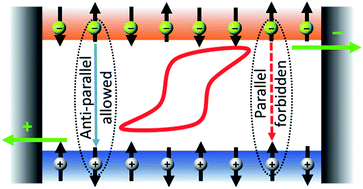
J. Mater. Chem. A, 2015,3, 15372-15385
https://doi.org/10.1039/C5TA01376C
Perovskite solar cells: film formation and properties
Perovskite solar cells have received considerable attention in recent years as a promising material capable of developing high performance photovoltaic devices at a low cost.
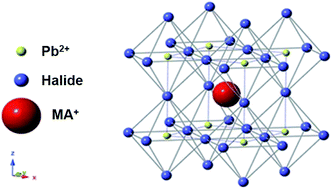
J. Mater. Chem. A, 2015,3, 9032-9050
https://doi.org/10.1039/C4TA05246C
Nanocarbons for mesoscopic perovskite solar cells
This review outlines the progress that has been reported on using carbon based nanostructures in perovskite solar cells and discusses their possible further applications to deliver high efficiency, long lifetime, low cost PSCs.
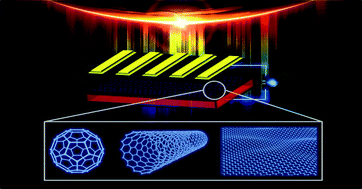
J. Mater. Chem. A, 2015,3, 9020-9031
https://doi.org/10.1039/C5TA00873E
Inorganic p-type contact materials for perovskite-based solar cells
Architectures of perovskite solar cells based on inorganic p-type semiconductor.
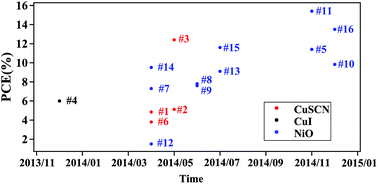
J. Mater. Chem. A, 2015,3, 9011-9019
https://doi.org/10.1039/C4TA06425A
Perovskite-based solar cells: impact of morphology and device architecture on device performance
This review provides an overview of factors affecting film morphology and how together with device architecture they impact perovskite cell performance.
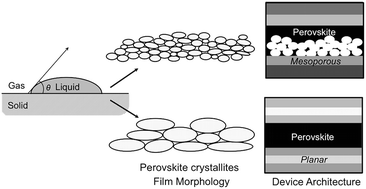
J. Mater. Chem. A, 2015,3, 8943-8969
https://doi.org/10.1039/C4TA05226A
Review of recent progress in chemical stability of perovskite solar cells
The understanding of how the chemical stability of PSCs is affected by oxygen and moisture, UV light, the solution process, and temperature was reviewed.
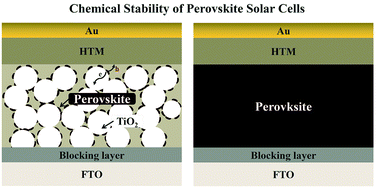
J. Mater. Chem. A, 2015,3, 8970-8980
https://doi.org/10.1039/C4TA04994B
Recent progress in organic–inorganic halide perovskite solar cells: mechanisms and material design
While energy shortage is always an issue, the impending exhaustion of fossil fuel sources makes it an ever increasingly pressing one.
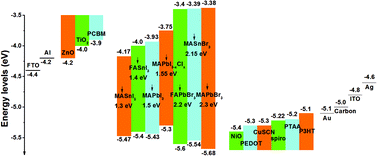
J. Mater. Chem. A, 2015,3, 8992-9010
https://doi.org/10.1039/C4TA04953E
Organic–inorganic halide perovskites: an ambipolar class of materials with enhanced photovoltaic performances
The synergistic interaction between experimentalists and theoreticians discloses the potentialities of hybrid organic–inorganic halide perovskites in their application in photovoltaics.
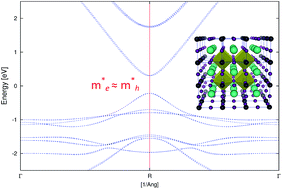
J. Mater. Chem. A, 2015,3, 8981-8991
https://doi.org/10.1039/C4TA05046K
Halide perovskite materials for solar cells: a theoretical review
First-principles calculations help to understand the fundamental mechanisms of the emerging perovskite solar cells and guide further developments.
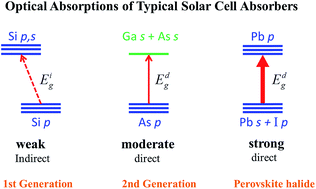
J. Mater. Chem. A, 2015,3, 8926-8942
https://doi.org/10.1039/C4TA05033A
Spiro-thiophene derivatives as hole-transport materials for perovskite solar cells
Spiro-thiophene derivatives act as promising hole transport materials for highly efficient perovskite solar cell application.
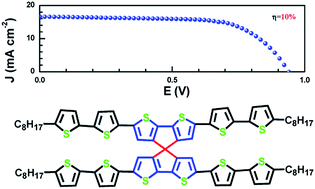
J. Mater. Chem. A, 2015,3, 12139-12144
https://doi.org/10.1039/C5TA01155H
Organic solvent vapor sensitive methylammonium lead trihalide film formation for efficient hybrid perovskite solar cells
Organic solvent vapor introduced during the formation of hybrid perovskite films changes the grain orientation and reduces charge recombination.
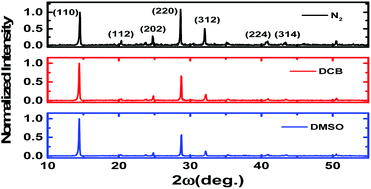
J. Mater. Chem. A, 2015,3, 9146-9151
https://doi.org/10.1039/C5TA01595B
Highly efficient, flexible, indium-free perovskite solar cells employing metallic substrates
Flexible perovskite solar cells with power conversion efficiencies of up to 10.3% have been prepared using titanium foil as an electrode substrate.
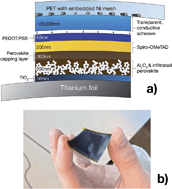
J. Mater. Chem. A, 2015,3, 9141-9145
https://doi.org/10.1039/C5TA01755F
Enhancing the photocurrent of perovskite solar cells via modification of the TiO2/CH3NH3PbI3 heterojunction interface with amino acid
Novel modification of the TiO2/CH3NH3PbI3 interface using glycine as a coupling agent induced higher coverage of perovskite through a two-step solution process.
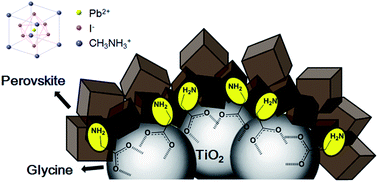
J. Mater. Chem. A, 2015,3, 9133-9136
https://doi.org/10.1039/C5TA01526J
High-performance hole-transporting layer-free conventional perovskite/fullerene heterojunction thin-film solar cells
MAPbI3 perovskite was found to be able to modify the work function of ITO, leading to sufficient charge extraction efficiency at the ITO/perovskite interface. A device with a high power conversion efficiency of >11% was obtained.
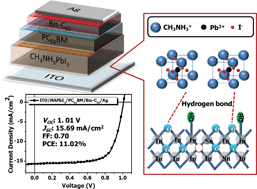
J. Mater. Chem. A, 2015,3, 9128-9132
https://doi.org/10.1039/C5TA01343G
Nonvolatile chlorinated additives adversely influence CH3NH3PbI3 based planar solar cells
Nonvolatile chlorinated additives can significantly improve the perovskite film morphology, yet adversely influencing CH3NH3PbI3 based planar solar cells.

J. Mater. Chem. A, 2015,3, 9137-9140
https://doi.org/10.1039/C5TA01198A
Rapid processing of perovskite solar cells in under 2.5 seconds
A rapid annealing technique for CH3NH3PbI3 perovskite solar cells is presented.
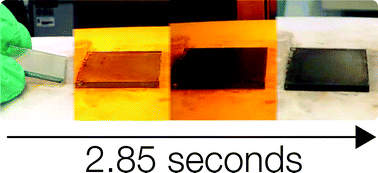
J. Mater. Chem. A, 2015,3, 9123-9127
https://doi.org/10.1039/C5TA00568J
Efficient mesoscopic perovskite solar cells based on the CH3NH3PbI2Br light absorber
Efficient CH3NH3PbI2Br perovskite solar cells have been prepared based on the TiO2/Al2O3/carbon architecture, yielding an appreciable power conversion efficiency of 11.03%.
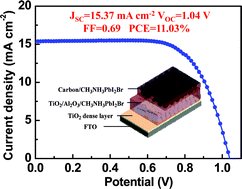
J. Mater. Chem. A, 2015,3, 9116-9122
https://doi.org/10.1039/C5TA01129A
Improving the TiO2 electron transport layer in perovskite solar cells using acetylacetonate-based additives
A facile and quantitative approach has been demonstrated to improve the TiO2 ETL in perovskite solar cells, with enhanced carrier extraction.
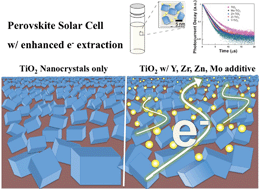
J. Mater. Chem. A, 2015,3, 9108-9115
https://doi.org/10.1039/C4TA06394E
The size effect of TiO2 nanoparticles on a printable mesoscopic perovskite solar cell
The size effect of the TiO2 photoanode has been investigated on the hole-conductor-free fully printable mesoscopic perovskite solar cells.
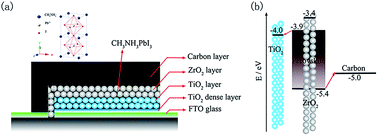
J. Mater. Chem. A, 2015,3, 9103-9107
https://doi.org/10.1039/C4TA07030E
High performance inverted structure perovskite solar cells based on a PCBM:polystyrene blend electron transport layer
Hybrid organic/inorganic perovskite solar cells are among the most competitive emerging photovoltaic technologies.
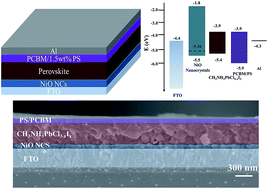
J. Mater. Chem. A, 2015,3, 9098-9102
https://doi.org/10.1039/C4TA05309E
Inkjet printing of CH3NH3PbI3 on a mesoscopic TiO2 film for highly efficient perovskite solar cells
CH3NH3PbI3 is deposited as a light absorber on a mesoporous TiO2 film and the structure and morphology are investigated at different table temperatures and with various amounts of added CH3NH3Cl. The optimized device exhibits the highest power conversion efficiency of 12.3% with an average value of 11.2%.
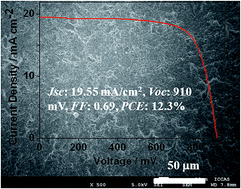
J. Mater. Chem. A, 2015,3, 9092-9097
https://doi.org/10.1039/C4TA05675B
Three-step sequential solution deposition of PbI2-free CH3NH3PbI3 perovskite
We demonstrate a facile approach for preparing PbI2-free CH3NH3PbI3 perovskite films via a three-step sequential solution process.
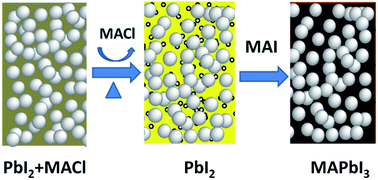
J. Mater. Chem. A, 2015,3, 9086-9091
https://doi.org/10.1039/C4TA05384B
Scalable route to CH3NH3PbI3 perovskite thin films by aerosol assisted chemical vapour deposition
An industrially relevant, scalable deposition route to high quality MAPI films is reported.
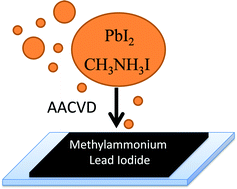
J. Mater. Chem. A, 2015,3, 9071-9073
https://doi.org/10.1039/C4TA05522E
Formation chemistry of perovskites with mixed iodide/chloride content and the implications on charge transport properties
We study the formation chemistry of Cl-doped perovskites by examining the chemical interactions between thermally evaporated MAI and PbCl2 through X-ray photoemission spectroscopy.
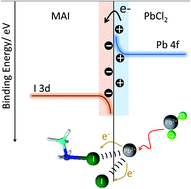
J. Mater. Chem. A, 2015,3, 9081-9085
https://doi.org/10.1039/C4TA05819D
Temperature-dependent hysteresis effects in perovskite-based solar cells
Time- and temperature-dependent photocurrent transient analysis suggests that hysteresis effects are associated with multiple charging–discharging processes in perovskite solar cells.
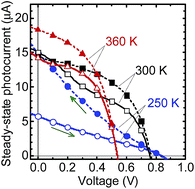
J. Mater. Chem. A, 2015,3, 9074-9080
https://doi.org/10.1039/C4TA04969A
Assessment of polyanion (BF4− and PF6−) substitutions in hybrid halide perovskites
The incorporation of tetrafluoroborate and hexafluorophosphate in halide perovskites is found to result in substantial band gap widening.
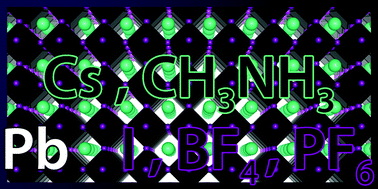
J. Mater. Chem. A, 2015,3, 9067-9070
https://doi.org/10.1039/C4TA05284F
Bulk heterojunctions push the photoresponse of perovskite solar cells to 970 nm
Implanting bulk heterojunctions into perovskite solar cells successfully pushes the photoresponse to 970 nm.
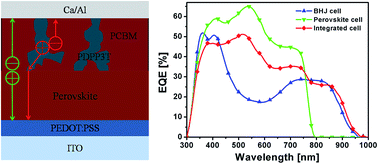
J. Mater. Chem. A, 2015,3, 9063-9066
https://doi.org/10.1039/C4TA04482G
The roles of alkyl halide additives in enhancing perovskite solar cell performance
C–X bond of alky halide additives cleavages during thermal annealing, resulting in frees halide ions to participate in perovskite formation.
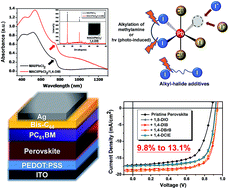
J. Mater. Chem. A, 2015,3, 9058-9062
https://doi.org/10.1039/C4TA05012F
Highly efficient perovskite solar cells based on a nanostructured WO3–TiO2 core–shell electron transporting material
A novel core–shell nanostructured WO3 is investigated in detail and shown to work successfully as an electron transporting material in hybrid perovskite solar cells. A thin TiO2 shell reduces charge recombination while highly textured single-crystal WO3 nanostructures promote fast electron transport leading to an efficiency above 11%.
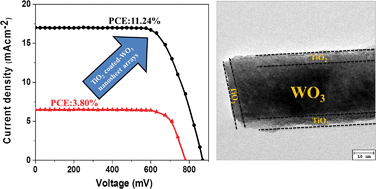
J. Mater. Chem. A, 2015,3, 9051-9057
https://doi.org/10.1039/C4TA04883K
A crosslinked fullerene matrix doped with an ionic fullerene as a cathodic buffer layer toward high-performance and thermally stable polymer and organic metallohalide perovskite solar cells
In this study, we developed a new cathodic buffer layer consisting of a cross-linked [6,6]-phenyl-C61-butyric styryl dendron ester (C-PCBSD) matrix and an ionic FPI dopant.
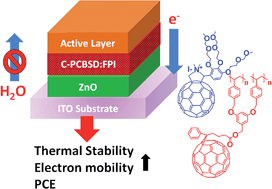
J. Mater. Chem. A, 2015,3, 20382-20388
https://doi.org/10.1039/C5TA05057J
Blue-luminescent organic lead bromide perovskites: highly dispersible and photostable materials
Blue-luminescent and dispersible organic–inorganic hybrid perovskites can be produced with a high reaction yield and valuable optical properties, such as luminescence quantum yield over 20% and high photostability under UV light. This material can be assembled–disassembled reversibly.
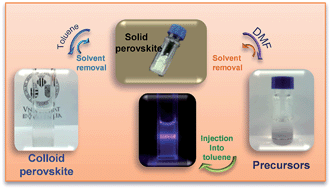
J. Mater. Chem. A, 2015,3, 14039-14045
https://doi.org/10.1039/C5TA01765C
Nanocolumnar 1-dimensional TiO2 photoanodes deposited by PVD-OAD for perovskite solar cell fabrication
1-Dimensional homogenous nanocolumnar structures prepared without any template method for efficient perovskite solar cell fabrication.
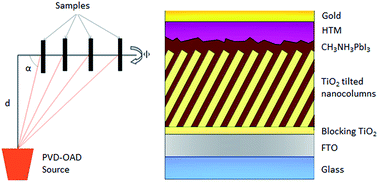
J. Mater. Chem. A, 2015,3, 13291-13298
https://doi.org/10.1039/C5TA02238J
Calculated optical absorption of different perovskite phases
We present calculations of the optical properties of a set of around 80 oxides, oxynitrides, and organometal halide cubic and layered perovskites (Ruddlesden–Popper and Dion–Jacobson phases) with a bandgap in the visible part of the solar spectrum.
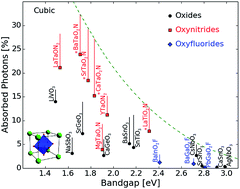
J. Mater. Chem. A, 2015,3, 12343-12349
https://doi.org/10.1039/C5TA01586C
Low-temperature SnO2-based electron selective contact for efficient and stable perovskite solar cells
We demonstrated compact SnO2 thin films prepared by sinter-less spin-coating processes as an electron selective contact for CH3NH3PbI3-based planar-heterojunction perovskite solar cells (PSCs).
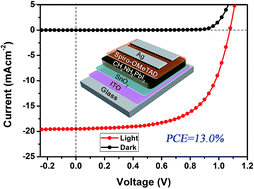
J. Mater. Chem. A, 2015,3, 10837-10844
https://doi.org/10.1039/C5TA01207D
A combined single crystal neutron/X-ray diffraction and solid-state nuclear magnetic resonance study of the hybrid perovskites CH3NH3PbX3 (X = I, Br and Cl)
This article describes a variable temperature solid-state NMR and single crystal X-ray/neutron diffraction study of the hybrid perovskites (CH3NH3)PbX3 (X = I, Br and Cl).

J. Mater. Chem. A, 2015,3, 9298-9307
https://doi.org/10.1039/C5TA01125F
Optical absorption, charge separation and recombination dynamics in Sn/Pb cocktail perovskite solar cells and their relationships to photovoltaic performances
Charge separation and recombination dynamics in Sn/Pb cocktail perovskite solar cells were clarified.
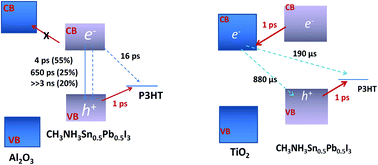
J. Mater. Chem. A, 2015,3, 9308-9316
https://doi.org/10.1039/C5TA01246E
Inverted perovskite solar cells with inserted cross-linked electron-blocking interlayers for performance enhancement
Cross-linked anode interlayers (X-QUPD or X-OTPD) with solvent-resistance provide electron blocking to reduce electron–hole recombination for improving PCE of invert type solution processed perovskite solar cells.
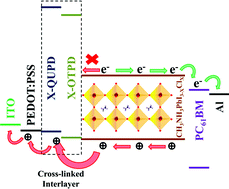
J. Mater. Chem. A, 2015,3, 9291-9297
https://doi.org/10.1039/C5TA01479D
Crown-ether functionalized fullerene as a solution-processable cathode buffer layer for high performance perovskite and polymer solar cells
A solution-processable PCBC cathode buffer layer improves the PCE of planar p–i–n perovskite solar cells based on CH3NH3PbI3−xClx to 15.08%.
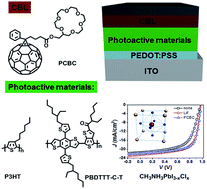
J. Mater. Chem. A, 2015,3, 9278-9284
https://doi.org/10.1039/C5TA01277E
Many-body interactions in photo-excited lead iodide perovskite
Lead halide perovskite is emerging as a promising semiconductor material for thin film solar cells.
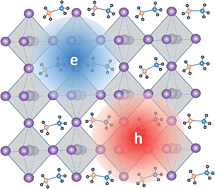
J. Mater. Chem. A, 2015,3, 9285-9290
https://doi.org/10.1039/C5TA01093D
High-performance and high-durability perovskite photovoltaic devices prepared using ethylammonium iodide as an additive
Perovskite solar cells display great commercialization potential. Ethylammonium iodide (EAI) has been used as an additive for perovskite solar cells. The EAI-derived devices displayed enhanced PCEs and long term thermal stability.

J. Mater. Chem. A, 2015,3, 9271-9277
https://doi.org/10.1039/C5TA01563D
Enhancement of photovoltaic properties of CH3NH3PbBr3 heterojunction solar cells by modifying mesoporous TiO2 surfaces with carboxyl groups
In a novel heterojunction solar cell employing CH3NH3PbBr3 (MAPbBr3) as the light absorber, the introduction of a carboxylate monolayer on the mesoporous TiO2 surfaces significantly enhances JSC as well as VOC.
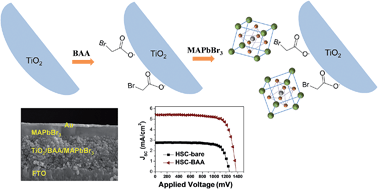
J. Mater. Chem. A, 2015,3, 9264-9270
https://doi.org/10.1039/C4TA06479H
Preparation of metal halide perovskite solar cells through a liquid droplet assisted method
Preparation of continuous and crystalline metal halide perovskite films for efficient solar cells using a liquid droplet assisted method.
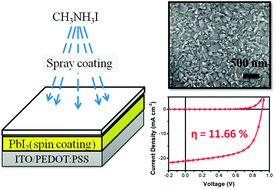
J. Mater. Chem. A, 2015,3, 9257-9263
https://doi.org/10.1039/C4TA06392A
Fatigue resistance of a flexible, efficient, and metal oxide-free perovskite solar cell
Highly flexible perovskite solar cells with good efficiencies and low hysteresis are prepared using a highly conductive PEDOT:PSS electrode.
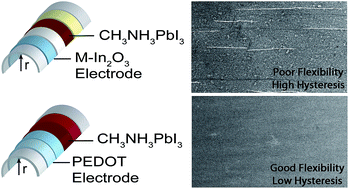
J. Mater. Chem. A, 2015,3, 9241-9248
https://doi.org/10.1039/C5TA00084J
Growth control of compact CH3NH3PbI3 thin films via enhanced solid-state precursor reaction for efficient planar perovskite solar cells
A new solution-processing method is demonstrated for the deposition of compact CH3NH3PbI3 perovskite thin films for high-efficiency planar solar cells.
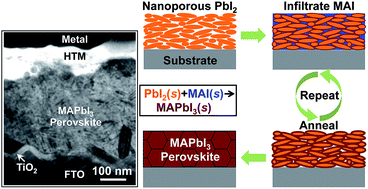
J. Mater. Chem. A, 2015,3, 9249-9256
https://doi.org/10.1039/C4TA07036D
Interplay of spin–orbit coupling and lattice distortion in metal substituted 3D tri-chloride hybrid perovskites
Metal and halogen substitution in hybrid perovskites reveals the interplay between spin–orbit coupling, structural distortions and many-body effects controlling band-gaps.
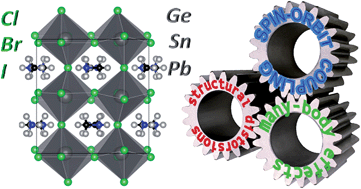
J. Mater. Chem. A, 2015,3, 9232-9240
https://doi.org/10.1039/C4TA06418F
Investigation on regeneration kinetics at perovskite/oxide interface with scanning electrochemical microscopy
Scanning electrochemical microscopy measurements show that the regeneration and absorption cross section of CH3NH3PbI3 are higher than conventional sensitizers.
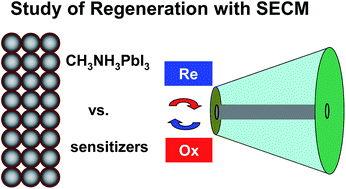
J. Mater. Chem. A, 2015,3, 9216-9222
https://doi.org/10.1039/C4TA06126H
Efficiency enhancement by defect engineering in perovskite photovoltaic cells prepared using evaporated PbI2/CH3NH3I multilayers
CH3NH3PbI3-based devices exhibiting a PCE of 12.5% have been achieved by annealing the evaporated precursor multilayers and treating the device constituent layers in a well controlled atmosphere.
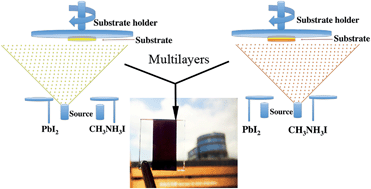
J. Mater. Chem. A, 2015,3, 9223-9231
https://doi.org/10.1039/C4TA05070C
Structure and function relationships in alkylammonium lead(II) iodide solar cells
Alkylammonium lead(II) iodide materials (APbI3), based on the general formula of CH3-(CH2)n-NH3PbI3, may lead to a monumental leap in developing affordable photovoltaics. Herein, we correlate the structure and function relationships of alkylammonium lead(II) iodide in solar cells.
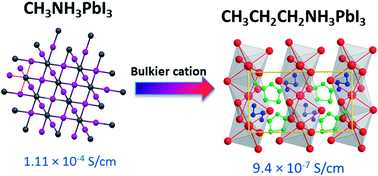
J. Mater. Chem. A, 2015,3, 9201-9207
https://doi.org/10.1039/C4TA06174H
Electronic and optical properties of mixed Sn–Pb organohalide perovskites: a first principles investigation
We investigate MASnxPb(1−x)I3 perovskites by first-principles simulations, finding monotonic variation of energy levels and band-gaps, and demonstrating balanced electron/hole transport.
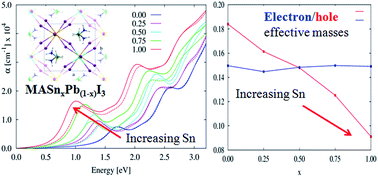
J. Mater. Chem. A, 2015,3, 9208-9215
https://doi.org/10.1039/C4TA06230B
Effect of different lead precursors on perovskite solar cell performance and stability
We present the use of halide (PbCl2) and non-halide lead precursors (Pb(OAc)2 (OAc = CH3CH2COO−), Pb(NO3)2, Pb(acac)2 (acac = (CH3COCHCOCH3)−) and PbCO3) for the preparation of perovskite solar cells.
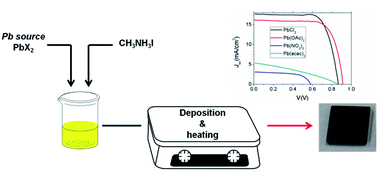
J. Mater. Chem. A, 2015,3, 9194-9200
https://doi.org/10.1039/C4TA06198E
Maximizing the emissive properties of CH3NH3PbBr3 perovskite nanoparticles
Highly luminescent and photostable CH3NH3PbBr3 nanoparticles have been prepared by fine-tuning the molar ratio between CH3NH3Br, PbBr2, a medium-size alkyl-chain ammonium salt, and 1-octadecene.
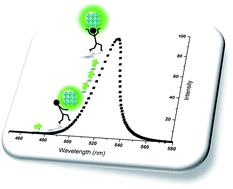
J. Mater. Chem. A, 2015,3, 9187-9193
https://doi.org/10.1039/C4TA05878J
Opto-electronic properties of TiO2 nanohelices with embedded HC(NH2)2PbI3 perovskite solar cells
A HC(NH2)2PbI3 perovskite solar cell based on TiO2 nanohelices has been developed.
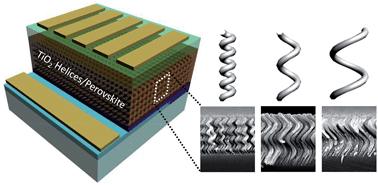
J. Mater. Chem. A, 2015,3, 9179-9186
https://doi.org/10.1039/C4TA04988H
Optical properties of organometal halide perovskite thin films and general device structure design rules for perovskite single and tandem solar cells
The optical constants of a CH3NH3PbI3−xClx perovskite thin film were acquired for the first time.
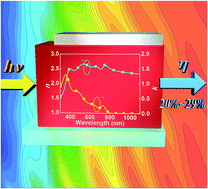
J. Mater. Chem. A, 2015,3, 9152-9159
https://doi.org/10.1039/C4TA05237D
Temperature dependence of hole conductor free formamidinium lead iodide perovskite based solar cells
This work reports on the temperature dependence of mixed perovskite cations, formamidinium and methylammonium, in hole conductor free solar cells.
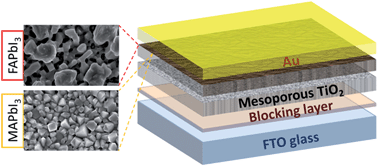
J. Mater. Chem. A, 2015,3, 9171-9178
https://doi.org/10.1039/C4TA05149A
The effect of carbon counter electrodes on fully printable mesoscopic perovskite solar cells
The size effect of graphite on hole-conductor-free fully printable mesoscopic perovskite solar cells was studied.
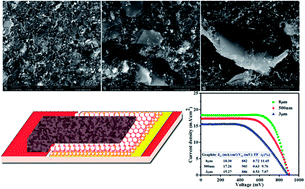
J. Mater. Chem. A, 2015,3, 9165-9170
https://doi.org/10.1039/C4TA04647A
Retarding charge recombination in perovskite solar cells using ultrathin MgO-coated TiO2 nanoparticulate films
MgO ultrathin nanolayers are able to efficiently retard charge recombination in perovskite solar cells.
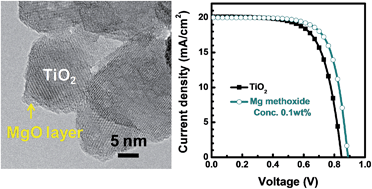
J. Mater. Chem. A, 2015,3, 9160-9164
https://doi.org/10.1039/C4TA03684K
Correction: Inorganic p-type contact materials for perovskite-based solar cells
J. Mater. Chem. A, 2015,3, 9318-9319
https://doi.org/10.1039/C5TA90087E
Correction: Structure and function relationships in alkylammonium lead(II) iodide solar cells
J. Mater. Chem. A, 2015,3, 9317-9317
https://doi.org/10.1039/C5TA90073E
About this collection
The breakthrough discovery of organometal halide perovskite materials as a superior converter to transform solar energy into electrical energy has completely changed the photovoltaic competition in the third-generation solar cells. In less than five years, the photovoltaic performance of perovskite-sensitized solar cells has reached over 15%. More intriguingly, the ambipolar transport property of organometal halide perovskite materials has been revealed, leading to the development of the simple planar heterojunction architecture perovskite solar cells with a high PCE close to 16%. To date, more and more scientists and engineers have been working on perovskite solar cells, greatly promoting the improvement of device efficiency as well as the understanding of this new star material for solar energy conversion. Due to these developments we would like to take this opportunity to launch this themed issue on perovskite solar cells.